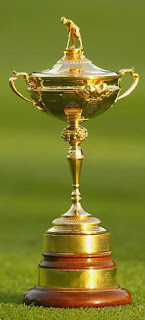The reason of course is the biennial contest between the best golfers in the Europe and those of the USA in the Ryder Cup. But who was Ryder and what is his cup?
It all started in 1926 with an rather innocuous announcement in The Times:
"Mr. S. Ryder, of St. Albans, has presented a trophy for annual competition between teams of British and American professionals. The first match for the trophy is to take place at Wentworth on June 4 and 5."
Although the 19 inch high solid gold trophy bears a hallmark for 1927 and was only first presented the following year in Worcester, Massachusetts. He also agreed to pay each of the winning players £5.
| Samuel Ryder |
He instead of teaching worked for a shipping company in Manchester, then for his father's business, before falling out with his father and moving south to St. Albans to join a rival seed merchant. But in the 1890s he combined the two jobs to make his fortune. He started to sell packets of seeds by post for a penny each, far cheaper than the competition. Posting them on Friday so they arrived in time for Saturday afternoon when working men had the afternoon off.
He was elected as a Liberal to St Albans Town Council in 1903 a role he filled for the next 13 years, including as mayor in 1905. But although he had played cricket in his youth he had not taken an active role in sport for much of his adult life, until in 1908 further illness led to a friend suggesting he take up golf. He took to it keenly earning a single figure handicap and making large donation to the Verulam Golf Club.
That first tournament announced in The Times was a rather informal affair, possibly because his cup wasn't ready to be presented. But in 1929 at Moortown for the first home match Ryder took delight in presenting the Cup to Britain's Captain George Duncan. He was only to see one more home tie in 1933 before passing away in 1936.
But what of his trophy?
It cost £250 to be made and is 17 inches (43 cm) high and nine inches (23 cm) from handle to handle. It is made of solid gold and bears a 1927 hallmark. It weighs 4 pounds (1.8kg). The player on top is the likeness of Abe Mitchell who Ryder paid £1,000 peer annum to be his personal coach as well as being one of the top British players of the 20s and 30s, however appendicitis prevented him taking part in the inaugural 1927 event, he did play in 1929, '31 and '33.
It left with the British team on the Aquitania from Southampton for that first Ryder Cup match in 1927.
That year there were four foursome matches (where teams of two play alternate shots) on the first day followed by 8 singles matches on the following day, with all the matches being over 36 holes. That was the format of the Ryder Cup matches until 1961.
In 1961 the matches were cut to 18 holes and there where eight foursomes (four each in the morning and afternoon) on the first day and 16 singles matches (eight in the morning and afternoon).
In 1963 the introduction of fourballs (teams of two each with their own ball) was introduced, now there were two sets of 4 foursomes on day 1, two sets of 4 fourballs on day 2 and 2 sets of eight singles matches on day 3. From 1973 the foursomes and fourballs were intermingled rather than all on one day. In 1977 for one match only there was only one set of each of the pairs matches but 10 consecutive singles matches. But the second sets of both pairs formats returned in 1979, with 6 morning and 6 afternoon singles matches (though a player could only be used once).
From 1981 the format we recognise was settled on. With the four foursomes and fourballs on each of the first two days followed by 12 consecutive singles matches on the final day.

No comments:
Post a Comment